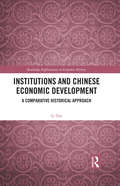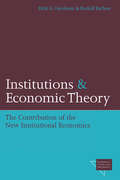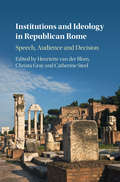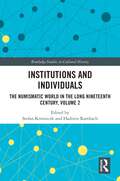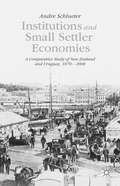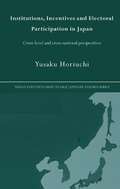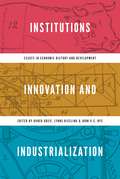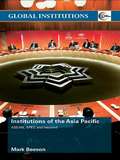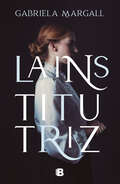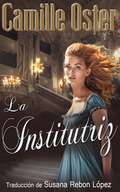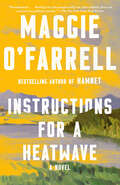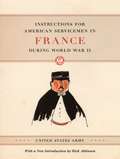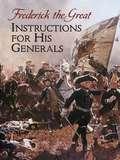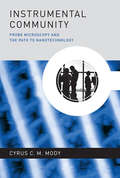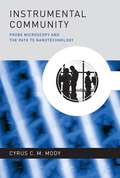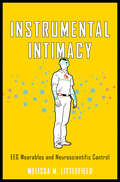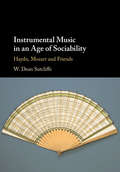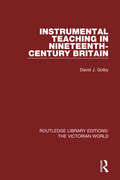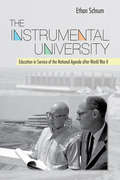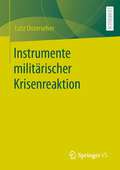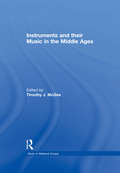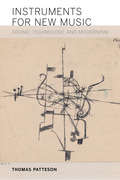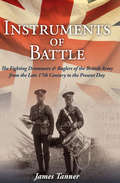- Table View
- List View
Institutions and Chinese Economic Development: A Comparative Historical Approach (Routledge Explorations in Economic History)
by Li TanChina’s rise as an economic power has posed some challenging questions: how did China achieve GDP growth that was even faster than the Four Asian Tigers? Is the "Chinese model" superior? Why hasn’t the rapid economic growth lead to democracy in the country as many observers expected? And can China sustain its rapid economic growth with its existing social system? Institutions and Chinese Economic Development: A Comparative Historical Approach explores these questions by studying the historical relationship between institutions and economic development in China, drawing comparisons with England, Japan and other Asian economies as appropriate. The investigation focuses on several junctures in China’s economic development: the starting point of the divergence between China and the West; the externally-provoked industrial development in the late 19th century; and the contemporary Chinese Miracle. The analysis foregrounds the role played by Chinese institutions and examines their effects on both the country’s failure to industrialize in the past and its economic achievements in recent time. The book also asks whether, without reform to the existing state institutions, China might still be subject to the historical dynastic cycles today, despite its recent economic success. This work is of great interest to students and scholars of the Chinese economy, economic history and institutional economics, as well as comparative history and Chinese studies more broadly.
Institutions and Economic Theory: The Contribution of the New Institutional Economics
by Furubotn Eirik G. Richter RudolfA much-needed exploration of the New Institutional Economics, or NIE, including a critical assessment of its central theoretical contributions since the field's early beginnings in the 1960s, is this book's objective. It traces the development of major ideas about the genesis and significance of institutions as these ideas have been presented in the NIE. Given the fundamental understanding underlying work in this new area of research--that transactions involve the use of real resources and have costs--the book views the NIE as an amalgam of transaction-cost economics, property-rights analysis, and contract theory. Efforts are made to explain how the various theoretical strands discussed in the NIE literature fit into the general fabric of modern institutionalism, and how the new concepts put forward can be applied to institutional analysis. Since the new institutionalist approach contrasts sharply with that of the traditional neoclassical model, special attention is given to elucidating the points of difference between the two. And, along these lines, a final chapter deals with the troubling question of whether neoinstitutionalist theory can be advanced by efforts to extend or generalize neoclassical theory. The book will be essential reading for economists attracted to the NIE approach. In addition, scholars from such disciplines as political science, sociology, and law will find the work useful as the NIE continues to gain wide academic acceptance. Eirik G. Furubotn is currently serving as Research Associate, University of Texas at Arlington; he recently retired as James L. West Professor of Economics, Texas A&M University. Rudolf Richter is Professor of Economics, Center for the Study of the New Institutional Economics, University of Saarlandes.
Institutions and Ideology in Republican Rome: Speech, Audience And Decision
by Catherine Steel Henriette Van Der Blom Christa GrayThis volume brings together a distinguished international group of researchers to explore public speech in Republican Rome in its institutional and ideological contexts. The focus throughout is on the interaction between argument, speaker, delivery and action. The chapters consider how speeches acted alongside other factors - such as the identity of the speaker, his alliances, the deployment of invective against opponents, physical location and appearance of other members of the audience, and non-rhetorical threats or incentives - to affect the beliefs and behaviour of the audience. <P><P>Together they offer a range of approaches to these issues and bring attention back to the content of public speech in Republican Rome as well as its form and occurrence. The book will be of interest not only to ancient historians, but also to those working on ancient oratory and to historians and political theorists working on public speech.<P> Offers a holistic and detailed picture of the dynamics and conditions behind world-changing events in Roman history.<P> Restores a focus on the content of public speech in Republican Rome, as well as its forms and occurrence.<P> All ancient languages are translated.
Institutions and Individuals: The Numismatic World in the Long Nineteenth Century, Volume 2 (Routledge Studies in Cultural History)
by Stefan KrmnicekThis second part of the 2 volume collection comprises a collection of essays in English by leading scholars on 19th century institutions and individuals presenting the latest developments in international scholarship on the numismatic world in the long 19th century. In the 19th century, developments in the study and collection of coins set the cornerstone for modern numismatics. This volume comprises a collection of essays in English by international leading scholars that highlight significant figures of 19th century research and the state of the numismatic trade in their time. Centering around collectors and scholars of ancient, medieval, modern, as well as on non-Western coinage and medals against the backdrop of the political, cultural, economic, and social changes of the era, this book presents the latest scholarship on numismatics’ contribution to the cultural history of the 19th century. This volume is essential for students and scholars alike interested in 19th century history and the history of coins.
Institutions and Small Settler Economies
by Andre SchlueterInstitutions and Small Settler Economies provides a comprehensive improvement in our understanding of institutional contributions to economic growth.
Institutions, Incentives and Electoral Participation in Japan: Cross-Level and Cross-National Perspectives (Nissan Institute/Routledge Japanese Studies)
by Yusaku HoriuchiAmerican and European political scientists have claimed that subnational elections almost always record lower voter turnout than national elections. In Japan, however, municipal elections often record considerably higher turnout than national elections, particularly in small towns and villages. Institutions, Incentives and Electoral Participation in Japan theoretically and empirically explores this puzzling 'turnout twist' phenomenon from comparative perspectives. Based on the rational-choice approach, the book hypothesizes that relative voter turnout in subnational vs. national elections is determined by the relative magnitudes of how much is at stake ('election significance') and how much votes count ('vote significance') in these elections.
Institutions, Innovation, and Industrialization: Essays in Economic History and Development
by Avner Greif Lynne Kiesling John V.C. NyeThis book brings together a group of leading economic historians to examine how institutions, innovation, and industrialization have determined the development of nations. Presented in honor of Joel Mokyr—arguably the preeminent economic historian of his generation—these wide-ranging essays address a host of core economic questions. What are the origins of markets? How do governments shape our economic fortunes? What role has entrepreneurship played in the rise and success of capitalism? Tackling these and other issues, the book looks at coercion and exchange in the markets of twelfth-century China, sovereign debt in the age of Philip II of Spain, the regulation of child labor in nineteenth-century Europe, meat provisioning in pre–Civil War New York, aircraft manufacturing before World War I, and more. The book also features an essay that surveys Mokyr's important contributions to the field of economic history, and an essay by Mokyr himself on the origins of the Industrial Revolution.In addition to the editors, the contributors are Gergely Baics, Hoyt Bleakley, Fabio Braggion, Joyce Burnette, Louis Cain, Mauricio Drelichman, Narly Dwarkasing, Joseph Ferrie, Noel Johnson, Eric Jones, Mark Koyama, Ralf Meisenzahl, Peter Meyer, Joel Mokyr, Lyndon Moore, Cormac Ó Gráda, Rick Szostak, Carolyn Tuttle, Karine van der Beek, Hans-Joachim Voth, and Simone Wegge.
Institutions of the Asia-Pacific: ASEAN, APEC and beyond (Global Institutions)
by Mark BeesonThe Asia-Pacific is arguably the most important, but also the most complex and contested, region on the planet. Containing three of the world’s largest economies and some of its most important strategic relationships, the region’s capacity of regional elites to promote continuing economic development whilst simultaneously maintaining peace and stability will be one of the defining challenges of the twenty-first century international order. Intuitively, we might expect regional institutions to play a major role in achieving this. Yet one of the most widely noted characteristics of the Asia-Pacific region has been its relatively modest levels of institutional development thus far. However, things are changing: as individual economies in the Asia-Pacific become more deeply integrated, there is a growing interest in developing and adding to the institutions that already exist. Institutions of the Asia-Pacific examines how this region is developing, and what role established organisations like APEC and new bodies like ASEAN Plus Three are playing in this process. An expert in the field, Mark Beeson introduces the contested nature of the very region itself – should it be the ‘Asia-Pacific’ or ‘East Asia’ to which we pay most attention and expect to see most institutional development. By placing these developments in historical context, he reveals why the very definition of the region remains unsettled and why the political, economic and strategic relations of this remarkably diverse region remain fraught and difficult to manage.
Institutions, Property Rights, and Economic Growth
by Sebastian Galiani Itai SenedThis volume showcases the impact of the work of Douglass C. North, winner of the Nobel Prize and father of the field of new institutional economics. Leading scholars contribute to a substantive discussion that best illustrates the broad reach and depth of Professor North's work. The volume speaks concisely about his legacy across multiple social sciences disciplines, specifically on scholarship pertaining to the understanding of property rights, the institutions that support the system of property rights, and economic growth.
La institutriz
by Gabriela MargallTras casi quince años de trabajar como institutriz en Argentina Elizabeth Shaw está decidida a volver a su pueblo natal en Inglaterra. Cuando su regreso es casi un hecho, una familia -a la que está unida por fuertes lazos- requiere de sus servicios y se reencontrará con Tomás Hunter, su amor de la juventud. ¿Podrá el amor vencer una red de secretos y un oscuro pasado? ¿A qué lugar pertenecemos? ¿Al lugar donde nacimos o a donde viven nuestros amores? ¿Al lugar con el que soñamos todas las noches? Elizabeth Shaw desea volver al pueblo donde nació, el puerto de Fowey, en el sur de Inglaterra. Huérfana desde los dieciséis años, su existencia ha transcurrido en casas ajenas, educando niños y jovencitas de alta sociedad en Buenos Aires. Disciplinada y dueña de firmes convicciones, su trabajo le permitió hacerse un nombre y convertirse en una institutriz apreciada y respetada. Cuando su regreso a Inglaterra es casi un hecho, una familia -a la que está unida por fuertes lazos- requiere su experiencia. La lealtad y sus sentimientos todavía vivos la llevarán a entrar en un hogar donde todas sus convicciones serán cuestionadas: un antiguo amor volverá a su vida, dos niños desamparados pondrán a prueba su capacidad y Elizabeth deberá lidiar con la pregunta sobre su verdadero origen.
La institutriz: un romance gótico victoriano
by Camille OsterViajar fuera de Inglaterra no estaba en la mente de la señorita Estelle Winstone, cuando recibió una respuesta a su anuncio postulándose como institutriz. El hecho de tener que viajar hasta Hungría, provocó que los nervios le revolvieran sus entrañas, al igual que tener que conocer al misterioso conde que sería su patrón. Al llegar a su destino, además de ser incapaz de hablar en húngaro ni siquiera lo básico, vio que el lugar estaba enclavado en unas montañas remotas, donde lobos hambrientos merodeaban fuera del sombrío y terrorífico castillo medieval en donde viviría, y el cual tenía una larga historia de tragedias, además de haber sido el escenario reciente de horrendos sucesos.
Instructions for a Heatwave: A novel (Vintage Contemporaries)
by Maggie O'FarrellSophisticated, intelligent, impossible to put down, Maggie O'Farrell's beguiling novels--After You'd Gone, winner of a Betty Trask Award; The Distance Between Us, winner of a Somerset Maugham Award; The Hand That First Held Mine, winner of the Costa Novel Award; and her unforgettable bestseller The Vanishing Act of Esme Lennox--blend richly textured psychological drama with page-turning suspense. Instructions for a Heatwave finds her at the top of her game, with a novel about a family crisis set during the legendary British heatwave of 1976. Gretta Riordan wakes on a stultifying July morning to find that her husband of forty years has gone to get the paper and vanished, cleaning out his bank account along the way. Gretta's three grown children converge on their parents' home for the first time in years: Michael Francis, a history teacher whose marriage is failing; Monica, with two stepdaughters who despise her and a blighted past that has driven away the younger sister she once adored; and Aoife, the youngest, now living in Manhattan, a smart, immensely resourceful young woman who has arranged her entire life to conceal a devastating secret. Maggie O'Farrell writes with exceptional grace and sensitivity about marriage, about the mysteries that inhere within families, and the fault lines over which we build our lives--the secrets we hide from the people who know and love us best. In a novel that stretches from the heart of London to New York City's Upper West Side to a remote village on the coast of Ireland, O'Farrell paints a bracing portrait of a family falling apart and coming together with hard-won, life-changing truths about who they really are.
Instructions For American Servicemen In France During World War II
by Rick Atkinson“You are about to play a personal part in pushing the Germans out of France. Whatever part you take—rifleman, hospital orderly, mechanic, pilot, clerk, gunner, truck driver—you will be an essential factor in a great effort. ” As American soldiers fanned out from their beachhead in Normandy in June of 1944 and began the liberation of France, every soldier carried that reminder in his kit. A compact trove of knowledge and reassurance,Instructions for American Servicemen in France during World War IIwas issued to soldiers just before they embarked for France to help them understand both why they were going and what they’d find when they got there. After lying unseen in Army archives for decades, this remarkable guide is now available in a new facsimile edition that reproduces the full text and illustrations of the original along with a new introduction by Rick Atkinson setting the book in context. Written in a straightforward, personal tone, the pamphlet is equal parts guidebook, cultural snapshot, and propaganda piece. A central aim is to dispel any prejudices American soldiers may have about the French—especially relating to their quick capitulation in 1940. Warning soldiers that the defeat “is a raw spot which the Nazis have been riding” since the occupation began,Instructionsis careful to highlight France’s long historical role as a major U. S. ally. Following that is a brief, fascinating sketch of the French character (“The French are mentally quick;” “Rich or poor, they are economical”) and stark reminders of the deprivation the French have endured under occupation. Yet an air of reassuring confidence pervades the final section of the pamphlet, which reads like a straightforward tourists’ guide to Paris and the provinces—like a promise of better days to come once the soldiers complete their mission. Written by anonymous War Department staffers to meet the urgent needs of the moment, with no thought of its historical value,Instructionsfor American Servicemen in France during World War IInevertheless brings to vivid life the closing years of World War II—when optimism was growing, but a long, demanding road still lay ahead.
Instructions for His Generals
by Frederick The Great Gen. Thomas R. PhillipsThe king of Prussia from 1740 to 1786, Frederick the Great ranks among eighteenth-century Europe's most enlightened rulers. In addition to abolishing serfdom in his domains and promoting religious tolerance, he was an ardent patron of the arts and an accomplished musician. "Diplomacy without arms," he observed, "is like music without instruments." Frederick's expertise at military matters is reflected in his successful defense of his territory during the Seven Years' War, in which he fought all the great powers of Europe. His brilliant theories on strategy, tactics, and discipline are all explained in this vital text."War is not an affair of chance," Frederick asserted, adding that "a great deal of knowledge, study, and meditation is necessary to conduct it well." In this book, he presents the fundamentals of warfare, discussing such timeless considerations as leadership qualities, the value of surprise, and ways to conquer an enemy who possesses superior forces. The soundness of his advice was endorsed by Napoleon himself, who once advised, "Read and re-read the campaigns of Alexander, Hannibal, Caesar . . . and Frederick. This is the only way to become a great captain and to master the secrets of the art of war."
Instrumental Community: Probe Microscopy and the Path to Nanotechnology (Inside Technology)
by Cyrus C. ModyHow networked structures of collaboration and competition within a community of researchers led to the invention, spread, and commercialization of scanning probe microscopy.The scanning tunneling microscope (STM) has been hailed as the “key enabling discovery for nanotechnology,” the catalyst for a scientific field that attracts nearly $20 billion in funding each year. In Instrumental Community, Cyrus Mody argues that this technology-centric view does not explain how these microscopes helped to launch nanotechnology—and fails to acknowledge the agency of the microscopists in making the STM and its variants critically important tools. Mody tells the story of the invention, spread, and commercialization of scanning probe microscopy in terms of the networked structures of collaboration and competition that came into being within a diverse, colorful, and sometimes fractious community of researchers. By forming a community, he argues, these researchers were able to innovate rapidly, share the microscopes with a wide range of users, and generate prestige (including the 1986 Nobel Prize in Physics) and profit (as the technology found applications in industry).Mody shows that both the technology of probe microscopy and the community model offered by the probe microscopists contributed to the development of political and scientific support for nanotechnology and the global funding initiatives that followed. In the course of his account, Mody charts the shifts in U.S. science policy over the last forty years—from the decline in federal basic research funding in the 1970s through the rise in academic patenting in the 1980s to the emergence of nanotechnology discourse in the 1990s—that have resulted in today's increasing emphasis on the commercialization of academic research.
Instrumental Community
by Cyrus C. M. ModyThe scanning tunneling microscope (STM) has been hailed as the "key enabling discovery for nanotechnology," the catalyst for a scientific field that attracts nearly $20 billion in funding each year. In Instrumental Community, Cyrus Mody argues that this technology-centric view does not explain how these microscopes helped to launch nanotechnology--and fails to acknowledge the agency of the microscopists in making the STM and its variants critically important tools. Mody tells the story of the invention, spread, and commercialization of scanning probe microscopy in terms of the networked structures of collaboration and competition that came into being within a diverse, colorful, and sometimes fractious community of researchers. By forming a community, he argues, these researchers were able to innovate rapidly, share the microscopes with a wide range of users, and generate prestige (including the 1986 Nobel Prize in Physics) and profit (as the technology found applications in industry). Mody shows that both the technology of probe microscopy and the community model offered by the probe microscopists contributed to the development of political and scientific support for nanotechnology and the global funding initiatives that followed. In the course of his account, Mody charts the shifts in U. S. science policy over the last forty years--from the decline in federal basic research funding in the 1970s through the rise in academic patenting in the 1980s to the emergence of nanotechnology discourse in the 1990s--that have resulted in today's increasing emphasis on the commercialization of academic research.
Instrumental Intimacy: EEG Wearables and Neuroscientific Control
by Melissa M. LittlefieldA critical examination of the rise of wearable EEG monitors.From Fitbits to GPS trackers, wearables promise to help us understand and improve ourselves in quantified ways. We count our steps, track our location, and even monitor our brain waves as we strive to achieve better fitness, clearer direction, or a more focused mind. But why do we rely on wearables to learn about ourselves? In Instrumental Intimacy, Melissa M. Littlefield questions our desire for mechanistic guidance by examining brain-based EEG wearables that promise to improve sleep, relationships, self-knowledge, and learning. Littlefield focuses specifically on EEGs’ transition out of the laboratory and into the hands of consumers. While other brain-imaging technologies (such as MRI, PET, and MEG) are used only in specialized laboratories, human electroencephalography (a.k.a. EEG) is embedded in portable, user-friendly devices. These direct-to-consumer wearables visualize brain activity as accessible data, and many offer the promise of self-optimization.Littlefield’s illuminating book brings the histories of EEG to bear on the contemporary development of EEG wearables via case studies of EEG-based sleep aids, bio-mapping instruments, fashionable surveillance tools, and athletic training devices. The author argues that, over the past century, applied uses of EEG helped to create new states of mind to be monitored and manipulated, as well as discourses about the existence of brain waves and their viability as a tool for brain optimization. By contextualizing and analyzing EEG wearables, Instrumental Intimacy provides a crucial intervention in an emergent consumer market and in the scholarly fields of STS, critical neuroscience, and the history of technology.
Instrumental Music in an Age of Sociability: Haydn, Mozart and Friends
by W. Dean SutcliffeSociability may be a key term of reference for eighteenth-century studies as a whole, but it has not yet developed an especially strong profile in music scholarship. Many of the associations that it brings do not fit comfortably with a later imperative of individual expression. W. Dean Sutcliffe invites us to face up to the challenge of re-evaluating the communicative rationales that lie behind later eighteenth-century instrumental style. Taking a behavioural perspective, he divides sociability into 'technical' and 'affective' realms, involving close attention both to particular recurring musical patterns as well as to some of the style's most salient expressive attributes. The book addresses a broad span of the instrumental production of the era, with Haydn as the pivotal figure. Close readings of a variety of works are embedded in an encompassing consideration of the reception of this music.
Instrumental Teaching in Nineteenth-Century Britain (Routledge Library Editions: The Victorian World)
by David GolbyFirst published in 2004, this book demonstrates that while Britain produced many fewer instrumental virtuosi than its foreign neighbours, there developed a more serious and widespread interest in the cultivation of music throughout the nineteenth century. Taking a predominantly historical approach, the book moves from a discussion of general developments and issues to a detailed examination of violin pedagogy, method and content, which indicates society’s influence on cultural trends and informs the discussion of other instruments and institutional training that follows. In the first study of its kind, it examines in depth the inextricable links between trends in society, education and levels of achievement. It also extends beyond profession and ‘art’ music to amateur and ‘popular’ spheres. A useful chronology of developments in nineteenth-century British music education is also included. This book will be of interest to those studying the history of instrumental teaching and Victorian music.
The Instrumental University: Education in Service of the National Agenda after World War II (Histories of American Education)
by Ethan SchrumIn The Instrumental University, Ethan Schrum provides an illuminating genealogy of the educational environment in which administrators, professors, and students live and work today. After World War II, research universities in the United States underwent a profound mission change. The Instrumental University combines intellectual, institutional, and political history to reinterpret postwar American life through the changes in higher education. Acknowledging but rejecting the prevailing conception of the Cold War university largely dedicated to supporting national security, Schrum provides a more complete and contextualized account of the American research university between 1945 and 1970. Uncovering a pervasive instrumental understanding of higher education during that era, The Instrumental University shows that universities framed their mission around solving social problems and promoting economic development as central institutions in what would soon be called the knowledge economy. In so doing, these institutions took on more capitalistic and managerial tendencies and, as a result, marginalized founding ideals, such as pursuit of knowledge in academic disciplines and freedom of individual investigators.The technocratic turn eroded some practices that made the American university special. Yet, as Schrum suggests, the instrumental university was not yet the neoliberal university of the 1970s and onwards in which market considerations trumped all others. University of California president Clark Kerr and other innovators in higher education were driven by a progressive impulse that drew on an earlier tradition grounded in a concern for the common good and social welfare.
Instrumentalists and Renaissance Culture, 1420–1600
by Coelho, Victor and Polk, Keith Victor Coelho Keith PolkThis innovative and multi-layered study of the music and culture of Renaissance instrumentalists spans the early institutionalization of instrumental music from c. 1420 to the rise of the basso continuo and newer roles for instrumentalists around 1600. Employing a broad cultural narrative interwoven with detailed case studies, close readings of eighteen essential musical sources, and analysis of musical images, Victor Coelho and Keith Polk show that instrumental music formed a vital and dynamic element in the artistic landscape, from rote function to creative fantasy. Instrumentalists occupied a central role in courtly ceremonies and private social rituals during the Renaissance, and banquets, dances, processions, religious celebrations and weddings all required their participation, regardless of social class. Instrumental genres were highly diverse artistic creations, from polyphonic repertories revealing knowledge of notated styles, to improvisation and flexible practices. Understanding the contributions of instrumentalists is essential for any accurate assessment of Renaissance culture.
Instrumente militärischer Krisenreaktion
by Lutz UnterseherNach den jüngsten Desastern bewaffneter Machtprojektion wird in diesem Buch unternommen, einen rationalen Diskurs über militärische Krisenintervention wiederzubeleben: im Sinne einer stabilitätsorientierten Sicherheitspolitik. Dabei werden Elemente der Landstreitkräfte auf ihre Eignung hin untersucht.
Instruments and their Music in the Middle Ages (Music In Medieval Europe Ser.)
by Timothy J. McGeeThis is a collection of twenty-nine of the most influential articles and papers about medieval musical instruments and their repertory. The authors discuss the construction of the instruments, their playing technique, the occasions for which they performed and their repertory. Taken as a whole, they paint a very broad, as well as detailed, picture of instrumental performance during the medieval period.
Instruments for New Music: Sound, Technology, and Modernism
by Thomas PattesonAt publication date, a free ebook version of this title will be available through Luminos, University of California Press' new Open Access publishing program for monographs. Visit www.luminosoa.org to learn more. Player pianos, radio-electric circuits, gramophone records, and optical sound film--these were the cutting-edge acoustic technologies of the early twentieth century, and for many musicians and artists of the time, these devices were also the implements of a musical revolution. Instruments for New Music traces a diffuse network of cultural agents who shared the belief that a truly modern music could be attained only through a radical challenge to the technological foundations of the art. Centered in Germany during the 1920s and 1930s, the movement to create new instruments encompassed a broad spectrum of experiments, from the exploration of microtonal tunings and exotic tone colors to the ability to compose directly for automatic musical machines. This movement comprised composers, inventors, and visual artists, including Paul Hindemith, Ernst Toch, Jörg Mager, Friedrich Trautwein, László Moholy-Nagy, Walter Ruttmann, and Oskar Fischinger. Patteson's fascinating study combines an artifact-oriented history of new music in the early twentieth century with an astute revisiting of still-relevant debates about the relationship between technology and the arts.
The Instruments of Battle: The Fighting Drummers and Buglers of the British Army from the Late 17th Century to the Present Day
by James Tanner“The hitherto forgotten story of the development of the regimental band, mainly drummers and buglers. A rare piece of social history” (Books Monthly).The Instruments of Battle examines in detail the development and role of the British Army’s fighting drummers and buglers, from the time of the foundation of the army up to the present day. While their principal weapon of war was the drum and bugle—and the fife—these men and boys were not musicians as such, but fighting soldiers who took their place in the front line.The origins of the drum and bugle in the classical period and the later influence of Islamic armies are examined, leading to the arrival of the drum and fife in early Tudor England. The story proper picks up post-English Civil War. The drum’s period of supremacy through much of the eighteenth-century army is surveyed, and certain myths as to its use are dispelled. The bugle rapidly superseded the drum for field use in the nineteenth century—until developments on the battlefield consigned these instruments largely to barrack life and the parade ground. But there are surprising examples of the use of the bugle in the field through both world wars as the story is brought up to modern day and the instruments’ relegation to an almost exclusively ceremonial role.This is all set against a background of campaigns, battles, changing tactical methods, and the difficult processes of command and control on the battlefield. Interwoven is relevant comparison with other armies, particularly American and French. Stories of the drummers and buglers themselves provide social context to their place in the army.
